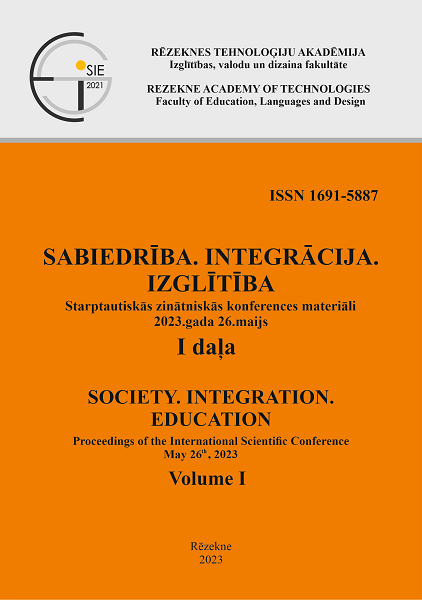DETERMINING THE KNOWLEDGE LEVEL OF PUPILS IN THE INFORMATION SYSTEM OF "SMART SCHOOL"
DOI:
https://doi.org/10.17770/sie2023vol1.7157Keywords:
array, association rule, fuzzy logic, information system, mathematical model, set elements, signs of similarity, smart school, time seriesAbstract
At a time when current information technologies are rapidly developing, the effectiveness of the quality of education in secondary schools, the transparency of the teacher evaluation system and the analysis of several other indicators with the help of artificial intelligence are the urgent issues of the day. In this method of analysis, initially the value is entered by school experts. This value consists of a pupil in a certain category among pupils and his grades. The term category refers to various criteria, such as pupils with different levels of mental activity, pupils who are learning poorly, who are missing a lot of lessons, and the level of learning is high or low within the specified subjects or topics. The "Smart School" information system forms arrays consisting of the number of grades and grades of pupils according to the criteria entered by experts, and has the ability to sort the values that are similar to the entered value. The solution to the problem posed in this article is explained mathematically and practically. Based on the proposed mathematical models, the business process was modeled, a business process software product was developed, and statistical data was obtained.
References
Agrawal, R., Imielinski, T., & Swami, A. (1993). Mining Association Rules between Sets of Items in Large Databases. In SIGMOD '93 Proceedings of the 1993 ACM SIGMOD international conference on Management of data, vol. 22, no. 2. Washington DC, USA, pp. 207-216.
Albayrak, A., Albayrak, M., & Bayir, R. (2015). Design of Matlab/Simulink based development board for fuzzy logic education, IEEE Int. Conf. Fuzzy Syst., vol. 2015–November.
Asemi, A. (2006). Information Technology and National Development in Iran. Paper presented at the 2006 International Conference on Hybrid Information Technology (ICHIT'06).
Box, G., Jenkins, G. M., & Reinsel, G. C. (2008). Time Series Analysis: Forecasting and Control. fourth ed. Hoboken, N.J., Wiley, New York.
Bustanov, X. A., & Xasanov, U. (2010). Oliygohlarda zamonaviy axborot ta’lim muhiti va ulardan foydalanishning metodik aspektlari.
Chandola, V., Banerjee, A., & Kumar, V. (2009). Anomaly detection: A survey. ACM Comput. Surv. 41, 3, Article 15 (July 2009), 58 p. DOI: http://doi.acm.org/10.1145/1541880.1541882
Chen, H., Yang, X., & Lyu, Y. (2020). Copy-Move Forgery Detection Based on Keypoint Clustering and Similar Neighborhood Search Algorithm. Special section on innovation and application of internet of things and emerging technologies in smart sensing. DOI: 10.1109/ACCESS.2020.2974804
Febriansyah, L. M. (2019). Analysis winnowing algorithm for text plagiarism detection using three method similarity. PROXIES, Vol. 2, No. 2, TAHUN.
García-Honrado, I. (2012). Fuzzy logic at schools and high schools? Annu. Meet. North Am. 3 Fuzzy Inf. Process. Soc. NAFIPS. Retrieved from: https://ieeexplore.ieee.org/document/6291033
Hennessy, S., Ruthven, K., & Brindley, S. (2005). Teacher perspectives on integrating ICT into subject teaching: commitment, constraints, caution and change. Journal of Curriculum Studies, 37(2), 155-192.
Henry, M., & Abala, A. (2009). E-learning research methods and approaches. Proceedings of the First Kuwait Conference on e-Services and e-Systems. Retrieved from: https://yuz.uz/uz/news/fargonadagi-aqlli-maktablarda-oquvchilar-bilimini-suniy-intellekt-baholamoqda
Hu, Y. C., Chen, R. S., & Tzeng, G. H. (2002). Mining fuzzy associative rules for classifications problems. Computers and Industrial Engineering, 43(4) pp. 735-750.
Ismail, M., & Syaiful, L. (2015). Affective assessment in learning using fuzzy logic. IEEE Conf. e-Learning, e-Management e-Services, pp. 98–102.
Mahmudi, J., Nalchigar, S., & Ebrahimi, S. B. (2008). Challenges of Smart Schools in Iran. Quarterly Journal of Educational Innovations, 7(27), 78-61
Muslimov, N. A (2015). Va boshqalar. Innovatsion ta’lim texnologiyalari. O’quv metodik qo’llanma. –T.: Sano standart, 2015.-208b.
Masharipov, S. A., Iskandarov, S. Q., & Sharifboyeva, R. B. (2022). Sun’iy intellekt asosida yoshlarni kasbga to‘g‘ri yo‘naltirish tizimini ishlab chiqish. International scientific conference "INFORMATION TECHNOLOGIES, NETWORKS AND TELECOMMUNICATIONS", ITN&T-2022 Urgench.
Melihov, A. N., Bershtejn L. S., & Karovin, S. Ja. (1990). Situacionnye sovetujushhie sistemy s nechetkij logikoj. M. Nauka. Gl.red. fiz.-mat. lit., 278 s.-ISBN 5-02-014144-5
Omidinia, S., Masrom, M., & Selamat, H. (2013). An Examination of the Concept of Smart School: An Innovation to Address Sustainability. 2nd International Conference on Advances in Computer Science and Engineering (CSE 2013).
Puteh, M., & Vicziany, A. M. (2004). How smart are Malaysia’s smart schools? 4th Global Congress on Engineering Education, Bangkok, Thailand, 5 – 9 July.
Sampebua, M., & Mangiwa, S. (2017). The Design Smart School Application to Increase Education in Junior High School. International Journal of Computer Science and Information Security (IJCSIS), Vol. 15, No. 10, October 2017
Tolipov, U. K., & Usmonboyeva, M. (2005). Pedagogik texnologiya: nazariya va amaliyot. T.: Fan, 205.
Ullah, F., Bajahzar, A., Aldabbas, H., Farhan, M., Naeem, H., Bukhari, S. S., & Malik, K. R. (2020). An E-Assessment Methodology Based on Artificial Intelligence Techniques to Determine Pupils’ Language Quality and Programming Assignments’ Plagiarism. Intelligent Automation And Soft Computing, Vol. 26, no. 1, 169–180.
Zadeh, L. A. (1965). Fuzzy Sets. Information and Control, 8, 338–353.
Zaenab, S., Zailin, M., & Yusoff, S. (2015). Are We ‘Smarter’ Now? Case Study of Smart School Implementation in a Developing Nation. Journal of Studies in Education, August.






